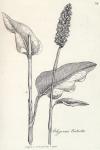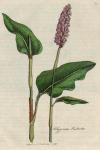
 Synonyma. Bistorta. Pharm. Lond. & Edinb.
Synonyma. Bistorta. Pharm. Lond. & Edinb.
Bistorta major. Gerard, emac. 399.
Bistorta major vulgaris. Park. Theat. 391.
Bistorta major rugosioribus foliis. J. Bauh. iii. 538.
Bistorta radice minus intorta. Bauh. Pin. 192. Raii Synopsis, 147. Raii Hist. 186. spec. 1.
Polygonum radice lignosa contorta, spica ovata, foliorum petiolis alatis. Hal. Stirp. Helv. No. 1558. Withering Bot. Arrang. 406. Flor. Dan. 421. Curtis Flor. Lond.
Class Octandria. Ord. Trigynia. L. Gen. Plant. 495.
Ess. Gen. Ch. Cor. 5-partita, calycina. Sem. 1, angulatum.
Spec. Char. P. caule simplicissimo monostachyo, foliis ovatis in petiolum decurrentibus.
The root is about the thickness of a finger, perennial, crooked, rugose, of a firm texture, and of a reddish or flesh colour, covered with a brown rind, and furnished with numerous small fibres and creepers: the stalk is simple, bending, solid, round, smooth, swelled at the joints, enclosed by the sheaths of the stipulas, and is a foot and a half or two feet in height; the radical leaves are ovalish, or rather heart-shaped, pointed, and stand upon long winged footstalks; the upper leaves embrace the stem, and are narrower and undulated. The flowers stand upon short footstalks, and terminate the stalk in an oblong close spike; the corolla is small, of tubular appearance, and divided into five oval obtuse segments, of a reddish white colour, and at the base supplied with several nectarious glands; the bracteal, or floral leaves, are membranous, withered, and each encloses two flowers; the filaments are tapering, white, longer than the corolla, and the antherae are purple; the styles are three, about the length of the stamina; the stigmata are small and round; the germen is triangular, of a red colour, and the seeds are brown and remarkably glossy.
Bistort [Bistora, quasi bis torta, twice twisted, or wreathen, is a modern name. Alston M. M. i. 399. "Radix est serpentis modo intorta." Whence it was called Serpentaria, Colubrina, and Dracunculus. And it has been variously considered to be the Oxylapathum, Britannica, and Limonium of the ancients. Vide Bauh. Pin. 192. Matth. 946.] is a native of Britain; [In the North of England this plant is known by the name of Easter-Giant, and the young leaves are eaten in herb pudding.] it grows in moist meadows, [It grows about Battersea, and by the side of Bishop's Wood near Hampstead. Curt. Flor. Lond.] and flowers in May and September. Every part of the plant manifests a degree of stipticity to the taste, and the root is esteemed to be one of the most powerful of the vegetable astringents. Lewis says, that this "astringent matter is totally dissolved both by water and reclined spirit; the root, after the action of a sufficient quantity of either menstruum, remaining insipid: on inspisating the tinctures, the water and spirit arise unflavoured, leaving extracts of intense stipticity." [Mat. Med. 154.]
The root of Bistort was formerly considered to be alexipharmic and sudorific; but its uses seem only to be derived from its styptic powers; it is therefore chiefly indicated in hemorrhages and other immoderate fluxes. Dr. Cullen observes, that the Bistort, "both by its sensible qualities, and by the colour it gives with green vitriol, and by the extracts it affords, seems to be one of the strongest of our vegetable astringents, and is justly commended for every virtue that has been ascribed to any other. As such we have frequently employed it, and particularly in intermittent fevers, and in larger doses than those commonly mentioned in Materia Medica writers. Both by itself, and along with gentian, we have given it to the quantity of three drams a day." [Mat, Med. ii. 40.] The dose of the root in substance is from a scruple to a dram.

